Top 35 Texas Deer Resistant Plants
Looking for Texas deer resistant plants? You’ve come to the right place! Start by downloading my free printable PDF of 10 Texas Deer Resistant Plants. You can take this handy one-pager with you to the plant nursery.
While there may be no such thing as deer-proof plants, these 35 Texas native plants are your best bet for having some plants left over when the deer come looking for food!
Even if you don’t live in Texas, many of these plants are native to other parts of the United States as well, so check them out for your garden.
Deer Overpopulation in Texas
In many ways, our the story of the white tailed deer is actually a major conservation success. By the early 1900s there were fewer than 500,000 remaining in North America due to over hunting. Today there are 30 million, with an estimated 5.3 million White Tailed Deer in Texas!
The deer population has grown rapidly over the last 50 years, in part due to conservation efforts, but also due to loss of their natural predators and more urbanization which provides them with additional food sources (i.e., our garden plants!).
The Texas Hill Country near where I live, has the highest white-tailed deer population in Texas. In certain areas the deer population exceeds the carrying capacity of the ecosystem, which is the maximum number of deer the ecosystem can support without degradation of habitat.
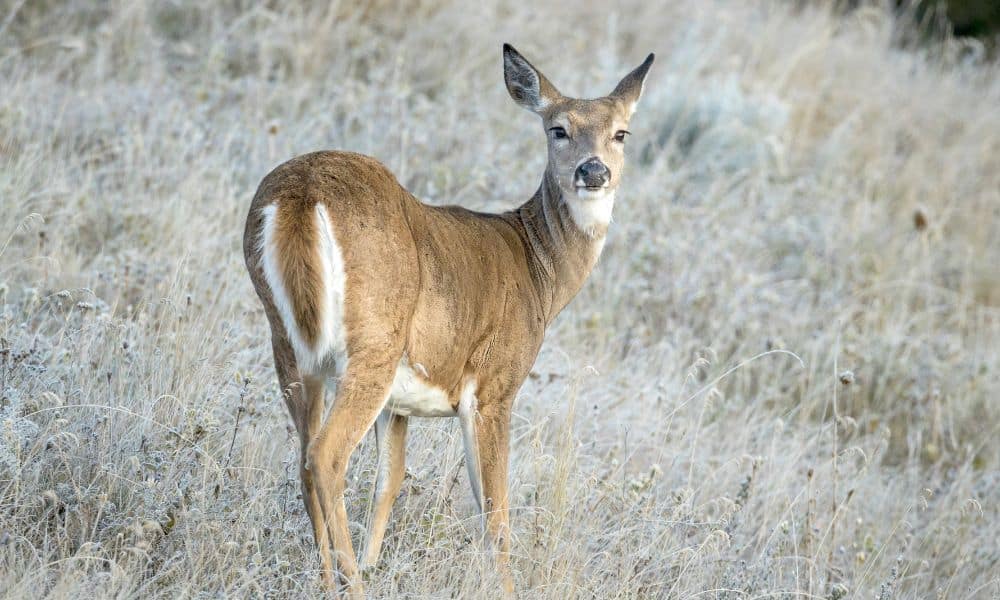
While a native garden should feed all wildlife including deer, adding these deer resistant plants to your garden will help ensure there will be some food left over for other species.
With less deer browsing, you’ll be able to provide nectar and pollen for pollinators, seeds for birds, and fruit for other small mammals. Plus you’ll have healthy plants to admire and enjoy in your garden!
Characteristics of Deer-Resistant Plants
As they say, a hungry deer will eat anything! Above all, they prefer the tender foliage of new plants and small plants. They tend to avoid plants once they get a certain size.
For your best chance at keeping the deer away, choose plants with these characteristics:
- Aromatic foliage / fragrant foliage
- Fragrant flowers
- Prickly or sharp foliage
- Milky or sappy foliage
- Fuzzy leaves
Top 5 Texas Deer Resistant Plants
Want to design a deer resistant garden? These are the five best plants in Texas for keeping the deer away.
This mix of Texas wildflowers and flowering shrubs are almost deer-proof! They would make a gorgeous garden bed that would attract pollinators from spring to fall:
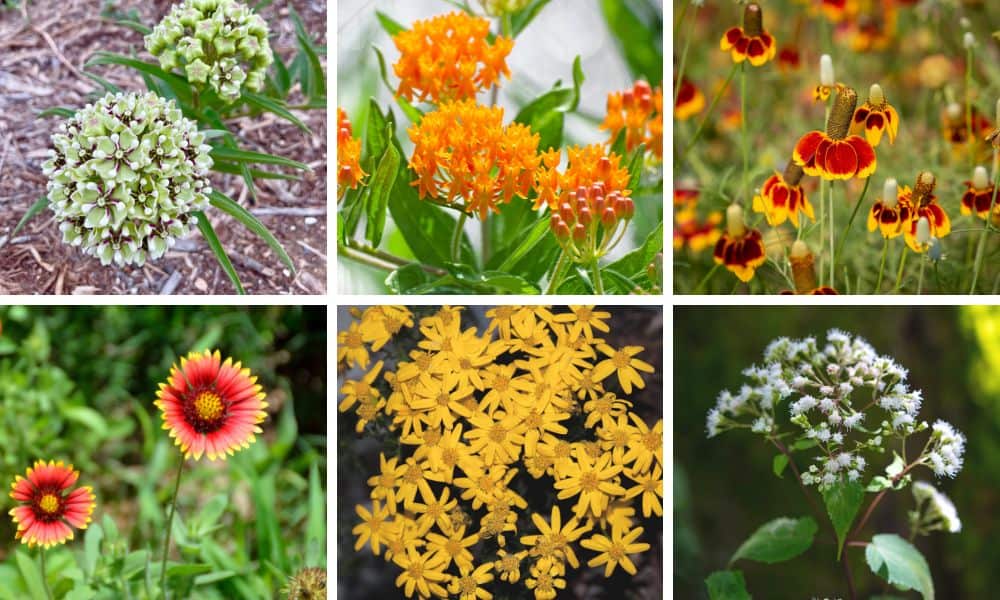
Bottom row: Indian Blanket, Damiantia, Shrubby Boneset.
1. Milkweed (Asclepias species)
Want to help Monarch populations while growing a plant that deer are unlikely to touch? Plant more Milkweed! It’s milky interior is a turn-off to deer. Add Milkweed to a full sun area of your yard.
If possible, choose a native variety of Milkweed instead of Tropical Milkweed (Asclepias curassavica), which is typically the variety sold at nurseries. Look for these natives instead:
- Swamp Milkweed (Asclepias incarnata)
- Butterfly Weed (Asclepias tuberosa)
- Antelope Horn Milkweed (Asclepias asperula)
If you plant Tropical Milkweed, be sure to cut it down to the ground by October 1st each year. Letting it grow year-round can cause a Monarch disease called OE.
2. Mexican Hat (Ratibida columnifera)
Some of the most popular Texas wildflowers tend to be some of the most deer resistant plants. Because the deer don’t touch them is one of the reasons they thrive! The plant has a strong odor that repels deer.
3. Indian Blanket (Gaillardia pulchella)
Indian Blanket is another deer-resistant wildflower that covers Texas roadsides in the late spring and summer. Apparently it is rabbit resistant too!
4. Damiantia (Chrysactinia mexicana)
This low-growing aromatic evergreen shrub repels deer while being covered in gorgeous yellow flowers several times throughout the growing season. They are very drought-tolerant plants too!
5. Shrubby Boneset (Ageratina havanensis)
Also known as Fragrant Mistflower, its foliage is unpalatable to deer. This is a great plant to add to your garden for fluffy white blooms in the fall. It is an important nectar plant for migrating butterflies.
Download the Free PDF: 10 Texas Deer Resistant Plants
I created a handy one-page PDF for you to print and take with you to the plant nursery. It includes a thumbnail photo of each plant along with its common and scientific names, size, sun needs and more! Get it here:

5 Annuals That Are Deer Resistant
Many of the best known wildflowers are some of the most deer proof annuals flowers around. It makes sense!
If you live in an area with a high deer population, sowing these wildflower seeds is a good way to start your garden. Get this deer-resistant wildflower seed mix.
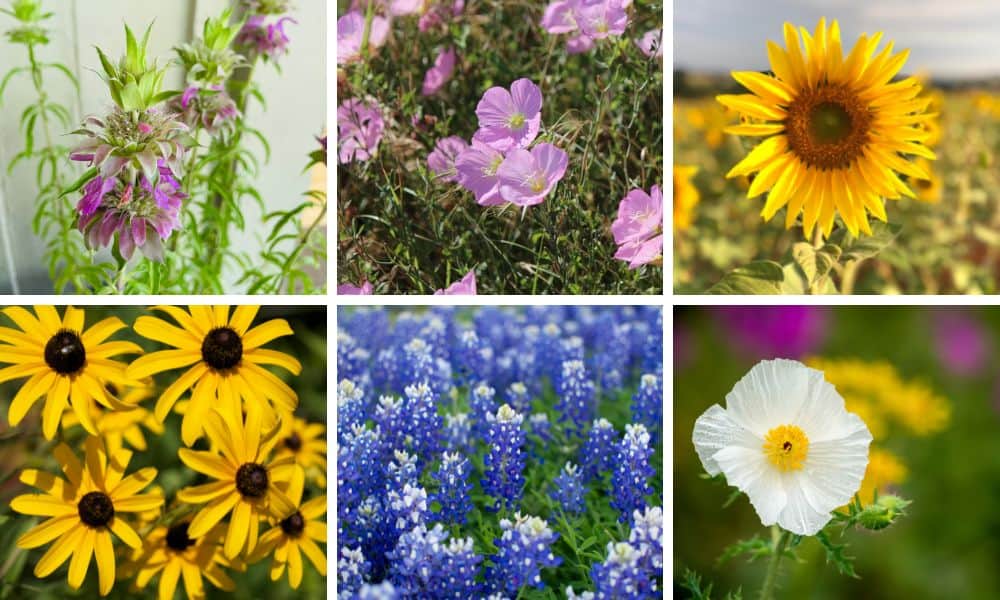
Bottom row: Black Eyed Susan, Texas Bluebonnets, White Prickly Poppy.
This list of plants is a must for a deer resistant wildflower bed:
1. Lemon Beebalm (Monarda citriodora)
This pretty wildflower is native to southern and central United States. It is a pollinator magnet while being deer resistant!
2. Pink Evening Primrose (Oenothera speciosa)
Another spring wildflower that is common in Texas and a great one to add to your wildflower bed that deer will avoid.
3. Annual Sunflower (Helianthus annuus)
In general, Annual Sunflowers are deer resistant, however they do tend to munch off the tops of young plants. Most will bounce back from some deer browsing.
4. Black Eyed Susan (Rudbeckia hirta)
This pollinator garden classic adds a nice pop of yellow and black to your garden while being left alone by deer thanks to its fuzzy leaves.
5. Bluebonnets (Lupinus texensis)
The Texas State Flower is also one that deer don’t tend to eat! Want to grow your own? Check out these 10 tips:
5 Deer Resistant Flowers Perennials
Perennial flowers are your garden mainstays – plant once and enjoy year after year! These five plants are your best investment for a deer resistant garden:
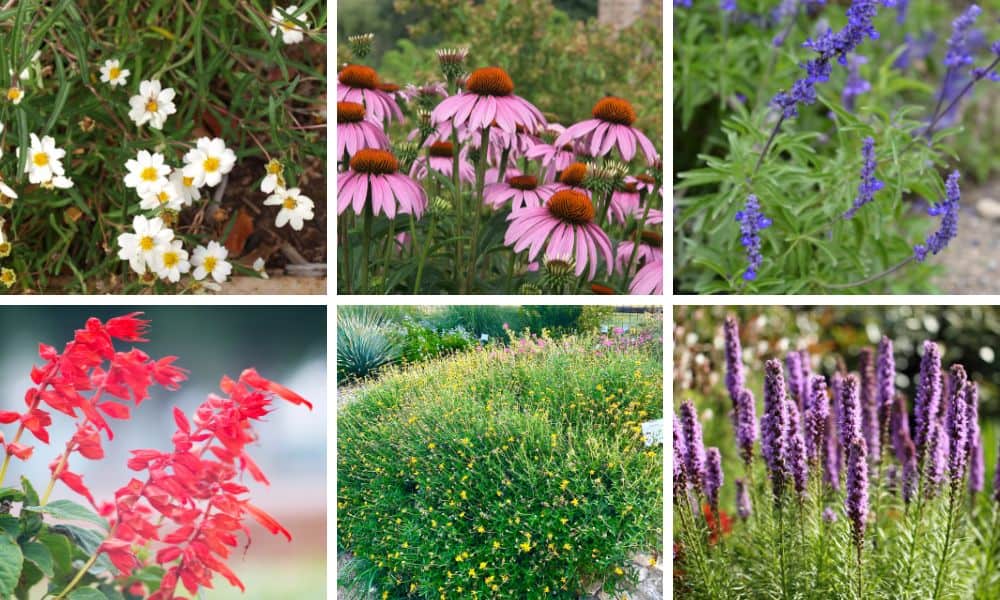
Bottom row: Scarlet Sage, Zexmenia, Gayfeather.
1. Blackfoot Daisy (Melampodium leucanthum)
A super drought-resistant, tough plant that requires little water. This one is a must for sunny areas accessible to deer.
2. Purple Coneflower (Echinacea purpurea)
This iconic flower native to the Eastern United States is fairly deer resistant. They don’t care for the texture or smell, but they will eat it if they are really hungry! Its purple long-lasting blooms are a must for your native garden.
3. Native Sage Plants (Salvia species)
Many of the native sage (Salvia) species are popular plants for native gardens, and are deer resistant due to their strong smell. These are a great addition to your garden with showy red and purple blooms that attract butterflies, bees and hummingbirds:
- Scarlet Sage (Salvia coccinea)
- Mealy Blue Sage (Salvia farinacea)
- Cedar Sage (Salvia roemeriana)
- Autumn Sage (Salvia greggii)
4. Zexmenia (Wedelia acapulcensis var. hispida)
This drought-tolerant plant with pretty yellow blooms looks especially nice flowing over a stone wall or in rock gardens. Great way to add a flush of yellow to your garden during hot Texas summers.
5. Gayfeather (Liatris species)
This pretty purple flower also called Blazing Star, blooms from summer to fall. Its tall purple spikes attract a variety of pollinators while being relatively deer resistant.
7 Deer Resistant Shrubs
These deer resistant shrubs can be the foundational plants in your garden – providing lots of color and structure while being left alone by deer:
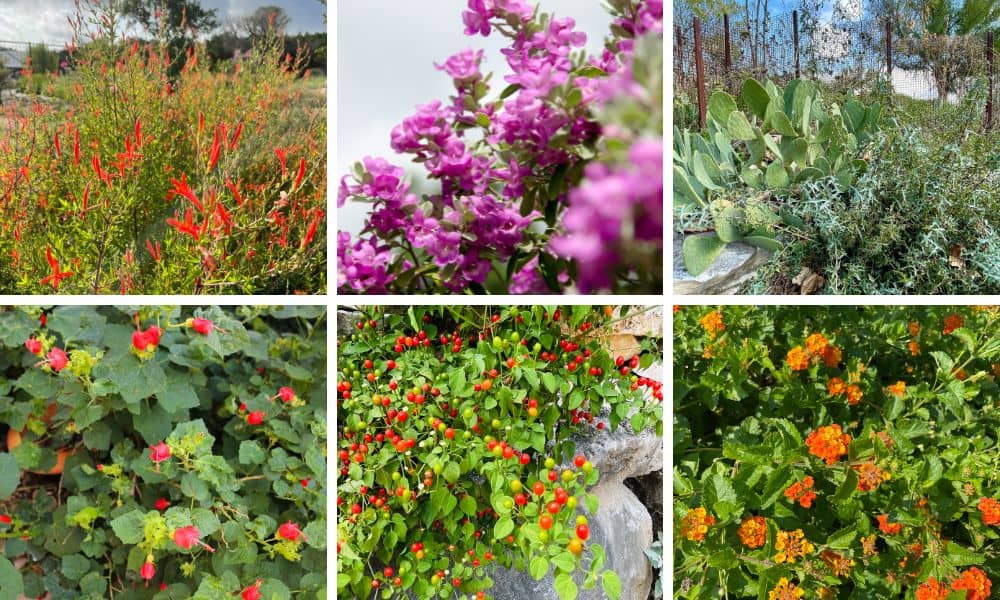
Bottom row: Turk’s Cap, Chili Petin, Texas Lantana.
1. Flame Acanthus (Anisacanthus quadrifidus var. wrightii)
This gorgeous shrub native to Central Texas is covered with red tubular blooms in the heat of the summer. It is a hummingbird and butterfly magnet while deer don’t care for it. Check out these five reasons to grow Flame Acanthus!
2. Cenizo (Leucophyllum frutescens)
This large shrub with silvery foliage is covered with purple blooms when there is high humidity after a rain. Deer tend to avoid this evergreen shrub.
3. Agarita (Mahonia trifoliolata)
Agarita is a great deer resistant plant thanks to its pokey leaves! It is covered with bright yellow blooms in the spring which attract a variety of bees and pollinators. The blooms are followed by bright red berries in early summer.
4. Turk’s Cap (Malvaviscus arboreus var. drummondii)
Turk’s Cap is a great deer resistant shade plant! It is a favorite with hummingbirds and provides edible fruit to birds and small mammals. It grows well in part sun to full shade. Learn more about growing Turk’s Cap.
5. Chili Pequin (Capsicum annuum)
The tiny hot peppers of Chili Pequin (also called Chili Petin) provide food for birds while keeping deer away. This part shade plant is a great way to add pops of red to your garden. You can use the peppers for a spicy salsa too!
6. Texas Lantana (Lantana urticoides)
Deer tend to leave Texas Lantana alone. When looking for this plant at the nursery, make sure you find the native variety (Lantana urticoides) with red and orange blooms. Avoid the purple trailing variety or the confetti variety (Lantana camara ‘Confetti’) as those are non-native invasive Lantana species in Texas.
7. Texas Prickly Pear (Opuntia engelmannii)
Of course the Texas Prickly Pear is a great deer resistant option as well. Pair it with Agarita for a great year-combo that looks good in the winter months as well!
5 Deer Resistant Trees
Deer will browse on trees too! It is especially important to protect new trees with some fencing around them to prevent deer browsing.
One of the best deer resistant trees is Texas Mountain Laurel. This small tree is evergreen and covered with purple flowers.
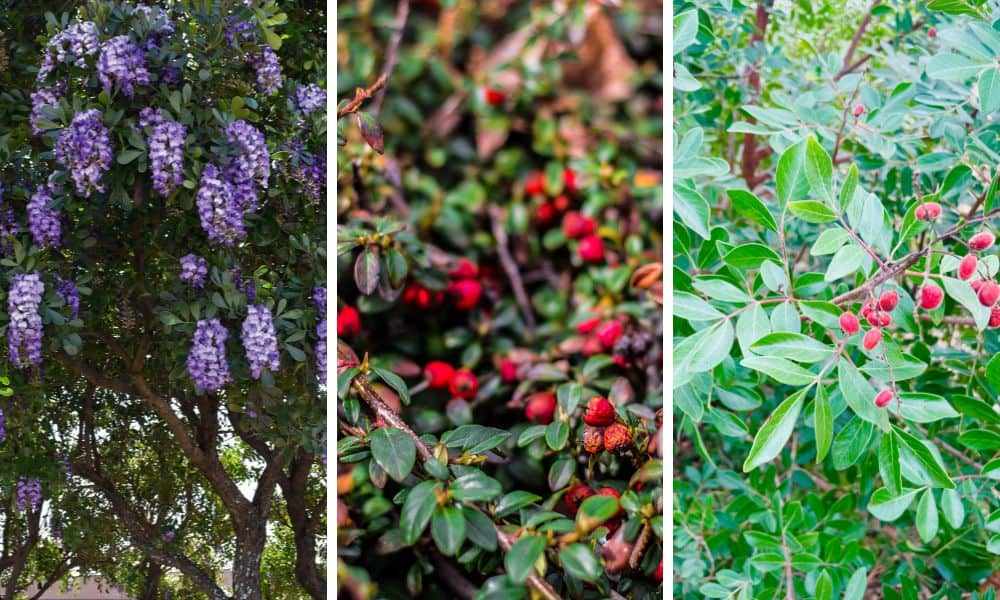
- Texas Mountain Laurel (Dermatophyllum secundiflorum)
- Yaupon Holly (Ilex vomitoria)
- Evergreen Sumac (Rhus virens)
- Flameleaf Sumac (Rhus copallinum)
- Texas Persimmon (Diospyros texana)
4 Deer Resistant Vines
There are several Texas native vines that are deer resistant. Vines are a great way to add vertical color and interest to your garden while providing nectar for pollinators.
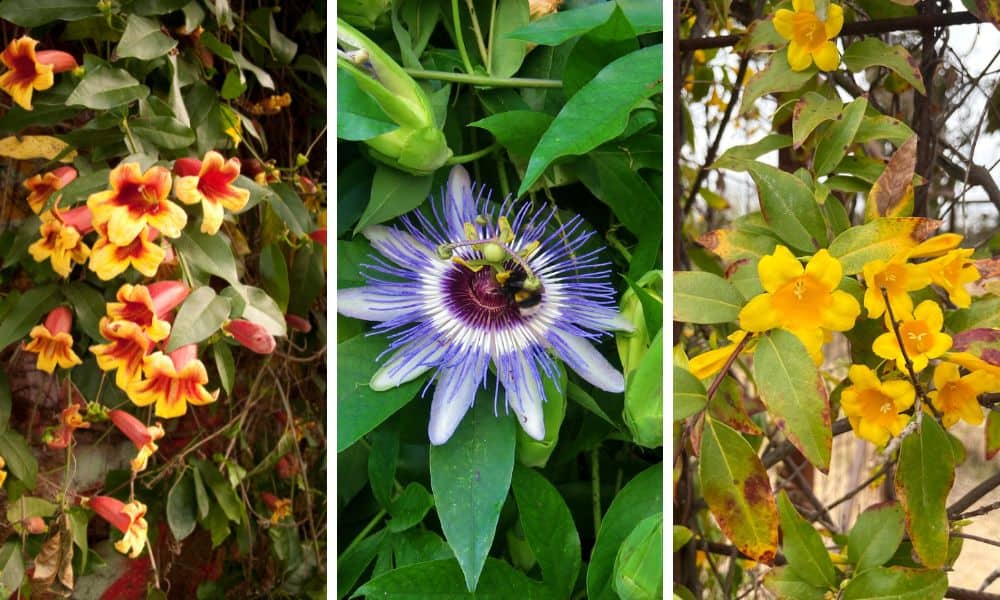
- Crossvine (Bignonia capreolata)
- Passionvine (Passiflora incarnata)
- Trumpet Creeper / Coral Vine (Campsis radicans)
- Carolina Jessamine (Gelsemium sempervirens)
5 Deer Resistant Ornamental Grasses
Last but not least, don’t overlook the impact that ornamental grasses can have in your garden. These plants look especially gorgeous in early fall when they develop their seed heads.
These prairie grasses also tend to be drought resistant thanks to their deep roots. Best of all, deer rarely eat them!
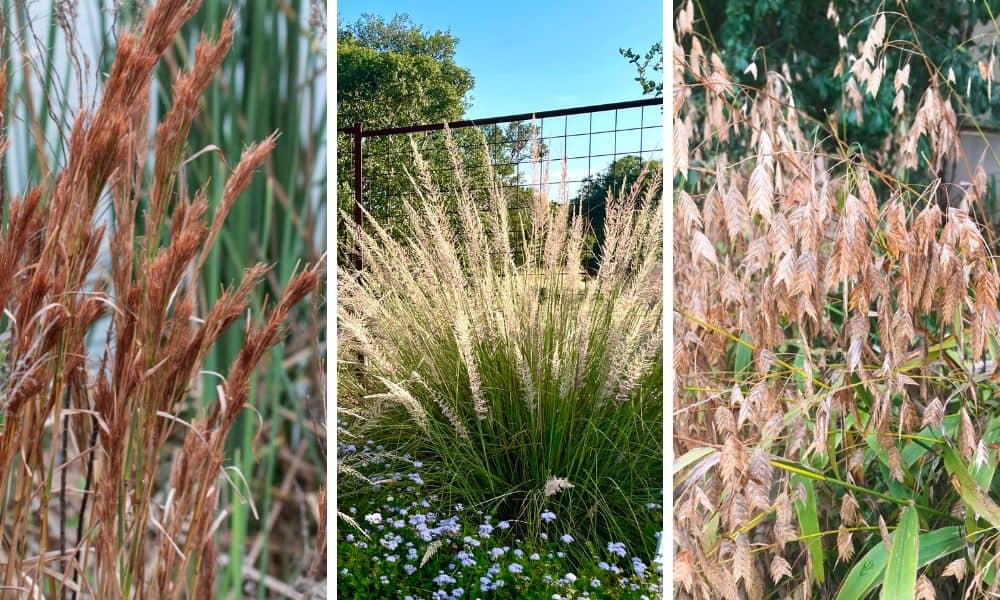
- Big Bluestem (Andropogon gerardii)
- Little Bluestem (Schizachyrium scoparium)
- Bushy Bluestem (Andropogon glomeratus)
- Lindheimer’s Muhly (Muhlenbergia lindheimeri)
- Inland Sea Oats (Chasmanthium latifolium)
Pin this to spread the word!
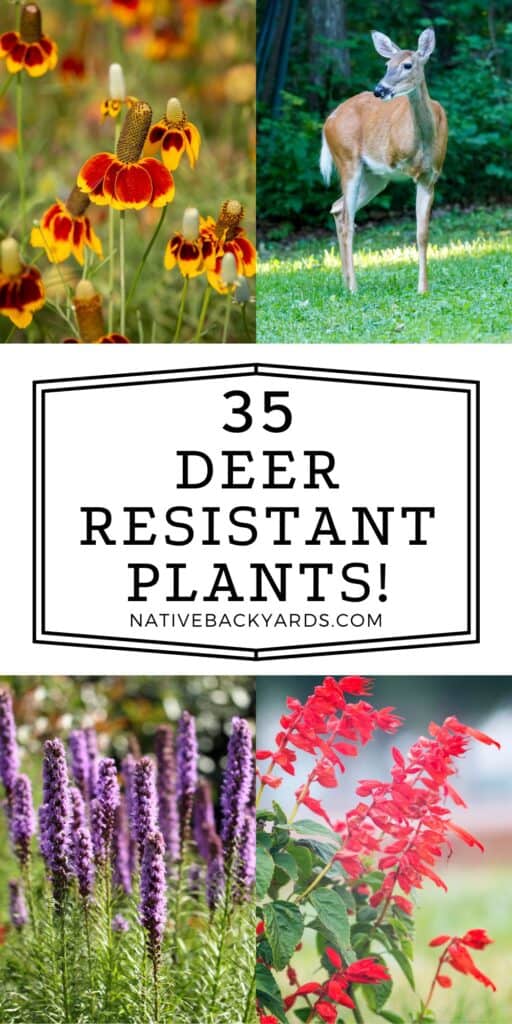

Welcome to Native Backyards! I’m Haeley from San Antonio, Texas, and I want to help you grow more native plants.
I have seen firsthand how the right plants can bring your yard to life with butterflies, bees, and birds. I’ve transformed my yard with Texas natives and I’m excited to share what I’ve learned with you.
Join my newsletter here! – each week I’ll send you helpful tips to make your native plant garden a reality!
Want to learn more about me and my garden? Check out my About page!

Do the deer know about your article?
Seriously, we live in Horseshoe Bay, near Marble Falls and are trying to re-landscape our house entrance. We always have deer in the yard browsing. So far, we’ve done a good job of keeping them at bay (we used a local landscape architect) but our planting got pretty beat up and a lot died following the Winter freeze in 2021-22. One grass we’d like to consider use is a giant liriope (maybe variegated). Is this a deer resitant grass? Thanks.
Hi Sam, from what I’ve read, it appears Liriope is deer-resistant. It is not a Texas native plant (it is native to Asia), however it is not invasive here in Texas and it is evergreen, so it is a nice landscaping option. We have it in our front yard landscaping as well, but we do not have deer in that area, so I don’t have first-hand experience with its deer resistance!
I recently planted very small lropia plants in my front yard. it was obvious the deer nibbled on them, pulled a couple up, and spit them out. They haven’t bothered with them since.
The deer in my area will eat Liriope to the ground. Proceed with caution. Maybe try one plant as a taste test before buying and planting more.